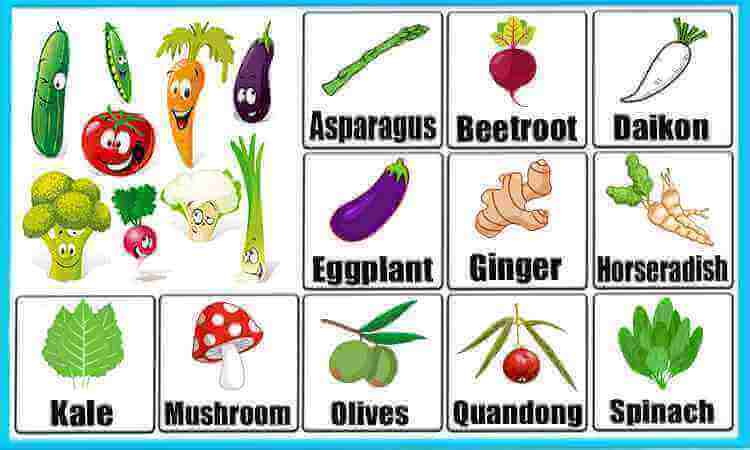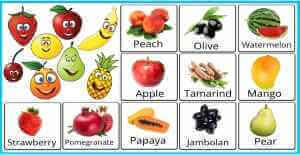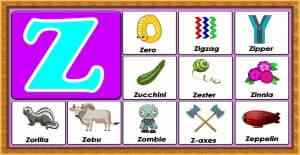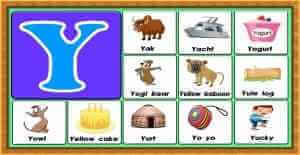Vegetable Names
Vegetable names are vibrant, flavorful, and obtainable in a wide range of flavors and textures! They’re a good source of vitamins, whether cooked or raw, so they’re a good meal choice for everyone who wants to keep strong and healthy. However, getting the kids to eat their vegetables isn’t always simple. Most youngsters prefer sweeter flavors, and they may find veggies overly bland when they consume them. The key is to make veggies attractive and enjoyable!
Learning the names of veggies might be an excellent way to introduce a new cuisine to your child. Knowing the many varieties of veggies expands children’s vocabularies. In addition, it provides an excellent chance to teach good eating habits, particularly via games and activities with fun while developing a taste for fresh food. This will ensure that kids are eager to consume veggies and overcome their phobia of eating new, nutritious foods.
Some vegetables, such as peas, are legumes. while others are vegetables, such as tomatoes or pumpkins, or herbs and spices, such as coriander or parsley; but, because of their usage in the kitchen, they are categorized as vegetables as well. You’ll discover a list of vegetable names, as well as games and activities, to assist you with this crucial duty.
Vegetable names for kids
Vegetables are vibrant, healthy, and available in a wide range of flavors and forms. It’s critical to include veggies names for kids in learning to provide a range of vegetables to your children, prepared in a variety of ways, in order to raise fussy children and maintain a nutritious diet. They are full of several vitamins that your body needs to stay healthy and execute its functions. They’re also a good source of minerals, making them a nutritious lunch choice for kids and adults. However, it’s a reality that most youngsters prefer sweeter flavors, and they may not find veggies appealing to their palates.
This page contains the names of vegetables in English and pictures of many types to help your youngster learn about them. We offer a list and description of most of the veggies, as well as photographs of how each one appears when your child encounters it. Not only are there names and photos, but there is also some basic information on the nutrient it contains and other advantages. So the next time you prepare one for him, he’ll be aware of it and all of its advantages. For your young one, the next article contains vegetable names for kids and vegetable information in English, including sorts, names, types, and photographs.
Vegetable Names from A to B for Kids
Asparagus: Garden asparagus is another name for this veggie. This distinguishes it from the hundreds of other asparagus varieties. Asparagus may be found growing wild throughout Europe, Africa, and Asia. Farmers and gardeners cultivate the crop in locations with cool or chilly winters.
Beans: Beans are a kind of seed that is commonly consumed. They’re a fantastic protein source. Beans may be found in a variety of meals, such as soups and chili. Beans are available in a wide range of hues, including white, green, yellow, tan, pink, red, brown, purple, and black. Some of them are virtually spherical or oval. Others are kidney-shaped or flat.
Broccoli: Broccoli belongs to the cabbage family of vegetables. Humans consume the blooming head and stem of broccoli, which is cultivated in the ground. Broccoli is usually green. However, some varieties are white or purple in color.
Bell Pepper: The term “capsicum” refers solely to bell pepper. In the local languages, bell pepper is known as “Shimla Mirch.” It is used in salads and dishes.
Vegetable Names from C for Kids
Corn: Corn is a cultivated cereal crop used for human nutrition as well as other uses. Corn is often referred to be a vegetable, yet it is both a grain and a vegetable in scientific and botanical terms. The plant’s seeds, known as kernels or grains, are consumed.
Cucumber: Cucumbers are a type of vegetable that is frequently used to produce pickles. Cucumbers are grown all over the world. Cucumbers are used in salads and sandwiches. They can also be pickled or preserved with salt and vinegar.
Celery: Celery is an ancient wetland plant that has been farmed as a vegetable. The stem of celery is tall and woody, tapering into leaves. The stalks, leaves, or hypocotyl of the plant are consumed and used in cooking, depending on the locale and cultivar. Celery seed is also a spice, and its extracts are utilized in pharmaceuticals.
Carrot: The taproot is the most widely consumed component of the carrot, which is a root vegetable. Carrots are typically orange in color, but purple, red, white, and yellow variations are also available. Carrots may be cooked and consumed in a variety of ways. For example, carrots may be used in carrot cakes because of their inherent sugars and sweetness.
Cauliflower: Cauliflower is a vegetable. It’s an annual that reproduces by seed. In most cases, just the head is consumed. Cauliflower heads are similar to broccoli heads, with the exception of flower buds. Cauliflower can be consumed raw, roasted, boiled, fried, or steamed. The outer leaves are removed before cooking, leaving only the florets.
Cabbage: Cabbage, often known as headed cabbage, is a leafy green or purple biennial plant planted for its dense leaved heads. It’s a vegetable with several layers. The cabbage may grow significantly larger in the summer when the days are long and sunny, as they do at high northern latitudes. Cabbage is frequently used in soups and stews. Cabbage soup is popular in Central and Eastern Europe, and cabbage is used in several borscht recipes. For salads, raw cabbage is frequently chopped into thin strips or shredded.
Vegetable Names from D to F for Kids
Daikon: Daikon is a winter radish with a long root and fast-growing leaves. The aaikon is a vegetable native to continental East Asia that is now farmed and consumed throughout the area and in South Asia and is now available worldwide. So, daikon is grown for its capacity to break up compacted soils and recover nutrients in some areas, while it is not harvested in others. Daikon roots are used to produce salads and a variety of pickles.
Eggplant: In temperate climes, the eggplant is a fragile tropical perennial that is generally grown as a sensitive or half-hardy annual. Spiny stems are common. The flower has a five-lobed corolla and golden stamens and is white to purple in color. The white flesh of the egg-shaped, glossy purple vegetable has a meaty quality. When the vegetable is cut open, the sliced surface of the flesh quickly becomes brown. The raw vegetable has a bitter or even astringent flavor, but it becomes supple and acquires a rich, nuanced flavor when cooked. The vegetable may absorb a lot of cooking fats and sauces, resulting in highly rich recipes, although salting cuts down on the quantity of oil absorbed.
Fluted pumpkin: The Nigerian fluted pumpkin (also known as Ugu) is widely planted in West Africa for its seeds and young leaves. Nigerian fluted pumpkins, like pumpkins, crawl along the ground and clamber up buildings using tendrils. However, growing fluted pumpkins is more usually done with the help of a wooden framework. The vegetable is inedible, but fluted pumpkin seeds are a great source of protein and fat and are extensively used in uncooking and medicine.
Vegetable Names from G to J for Kids
Garlic: Garlic is a closely related plant to the onion. Its bulbs are used in a variety of dishes. Garlic is a plant that grows year after year. This indicates that it has a long life span. Garlic has a strong onion-like aroma as well as a strong flavor. To flavor soups, stews, and salad dressings, peel the cloves and slice or crush them.
Ginger: Ginger is a perennial plant with a strong, fragrant rhizome (underground stem) that is mostly used as a spice and flavoring. The spice has a bitter taste and is used in bread, sauces, curry meals, confections, pickles, and ginger ale.
Green pepper: Green peppers are produced by a variety of garden plants. They are used to flavor meals and are consumed as veggies.
Horseradish: Horseradish is a condiment made from the horseradish plant’s root. The horseradish has a strong, spicy flavor. Horseradish tastes powerful and pungent when combined with vinegar, yet it does not create tears.
Iceplant: The ice plant derives its name from the tiny, transparent engorged hairs that seem like frozen water droplets on the surface of the leaves. The ice plant treats abdominal fluid retention, diarrhea, liver and kidney disorders, and pneumonia. In addition, it soothes itching, discomfort, swelling, and redness of the skin when applied externally.
Jalapeno: The jalapeno is a Mexican pepper variety. It is commonly harvested and consumed when still green, but it is also allowed to fully mature and turn red, orange, or yellow on rare occasions. In many American restaurants, stuffed jalapenos are served as an appetizer. They can be baked or deep-fried. Toss diced raw jalapenos into fresh salsas like pico de gallo or mango salsa to enhance flavor—roast jalapenos before adding them to salsas and sauces to add a depth of smokiness.
Vegetable Names from K to O for Kids
Kale: Kale is a leafy green or purple vegetable. Vitamin A and omega-three fatty acids are abundant in this green vegetable. It also has a great flavor.
Lettuce: Lettuce is the most commonly grown salad green. The stems and leaves can both be eaten. Salads and sandwiches benefit from the taste and crunch that lettuce provides. Stem lettuce is used in stews and many Asian recipes.
Mushroom: Mushrooms is a fungus that is quite prevalent. They may be found growing in woodlands or grassy regions with an abundance of moisture all around the world. Some mushroom species are edible, but others are toxic. Toadstools are another name for toxic kinds. Mushrooms are widely utilized in cooking and may be found in a variety of cuisines.
Nettles: Plants with stinging defense hairs, such as stinging nettles (Urtica dioica), are known as stinging nettles. For thousands of years, it has been utilized as a herbal treatment.
Onion: The onion is a bulbous plant with crisp, meaty layers. It may be cooked or eaten raw and is prized for its taste. Onions have an oil that is high in sulfur minerals. When the onion is chopped, this oil is expelled into the air. The oil reacts with the fluid in the eyes, causing them to tear. Onions have been utilized in medicine in addition to being used in cooking.
Olive: Olive trees have been produced for their vegetable and oil since ancient times. Hand-picked or shaken olives are hand-picked or shaken from the tree. Olives are frequently plucked when they are still green and immature. The majority of olives are farmed for the production of olive oil. Olive oil and olives are used in a variety of cuisines.
Vegetable Names from P to Q for Kids
Potato: Potatoes are vegetables, yet they contain a lot of starch (carbohydrates), making them nutritionally similar to rice, pasta, and bread.
Pea: Peas are spherical, tiny vegetables. They’re high in protein and vitamin-rich. Peas are one of the oldest crops on the planet. When pea pods are mature or ready to eat, they split in half. Therefore, the peas within most pods are the sole thing that makes them valuable. However, certain types, such as snap and snow peas, have edible pods. Fresh, dry, canned, and frozen peas are available.
Pumpkin: Pumpkins are a type of vegetable that is often produced for consumption. Cooked and consumed indoors or used to create bread, soups, and pies. Squashes, gourds, cucumbers, and melons are all related to pumpkins. Squashes are a sort of pumpkin that comes in a variety of shapes and sizes. They can be kept in a dry area for a few months. People roast and consume pumpkin seeds in addition to cooking with pumpkins. Animals are also fed pumpkins.
Quandong: The vegetable of the desert quandong tree may be cooked to produce pie filling for quandong pies or turned into a vegetable juice drink. The seed (kernel) inside the tight shell may be removed and mashed into a paste, which can then be used to relieve discomfort from sore gums or an oral gum boil.
Vegetable Names from R to T for Kids
Radish: Radishes are farmed and eaten all over the world. The majority of them are eaten raw as a crisp salad vegetable with a bite. The oils in radishes give them a distinct, pungent taste. Radishes are often cultivated for their roots, but some people prefer eating the young, sensitive leaves known as radish sprouts. Daikon radishes are farmed for their oil-producing seeds, which are pressed.
Red cabbage: Red cabbage is a nutrient-dense vegetable. The purple-reddish hue of this cabbage type comes from the way it is grown. It’s high in nutrients, and has a long list of health advantages, much like other colorful veggies.
Red pepper: They’re vibrantly colored, crispy, and really tasty. They have the highest amount of vitamin C content of any vegetable and may be prepared in a variety of ways. You may eat them fresh, grilled, or in soups, stews, and other recipes.
Swede: The cabbage family includes the swede. Swede is used in stews, casseroles, soups, roasts, fried chips, and as a potato substitute.
Sweet Potato: Sweet Potatoes are a kind of plant. Sweet potatoes are high in fiber. They are consumed all around the world.
Spinach: Spinach is a leafy green vegetable that comes in a variety of colors. Popeye, the cartoon character, consumes spinach to get strength. It’s eaten raw as a salad green or cooked as a vegetable. Soups and dips can also be made with it.
Tomato: Tomatoes are a well-known vegetable. They can be either raw or cooked. Tomato juice and canned tomatoes are also popular. It’s gleaming and silky. It has a large number of tiny seeds. It is also extremely beneficial to one’s health. Most tomatoes are red.
Vegetable Names from U to W for Kids
Umbrella squash: Squashes are a type of vegetable that is grown all over the world. Squashes are frequently used in soups and as side dishes. Bread and muffins may be made with zucchini and other summer squashes. Squash blooms are occasionally consumed as well. In addition, squashes are often used to feed agricultural animals.
Vagem: Snow pea, mangetout, and sugar pea are all common names for the same vegetable. When poured over the boiling carrots and mangetout, the red wine gravy was also incredibly flavorful and rich.
Watercress: A watercress is a plant that grows in a watery environment. It, like certain other leaf vegetables, belongs to the Brassicaceae family. People cultivate them to eat, and they’re frequently used in salads and sandwiches. They have a spicy flavor and grow quickly. Watercress is a plant that is related to cabbage and mustard.
Vegetable Names from X to Z for Kids
Ximenia: The hog plum, yellow plum, tallowwood, and sea lemon are all names for the Ximenia. The tree’s leaves are oval in form and vivid green. The plant smells strongly like almonds. The vegetables have a plum-like taste to them. The young leaves are prepared as a vegetable in Asia. The leaves, however, contain cyanide and must be fully boiled before eating. Therefore, you should not be consume them in large quantities.
Yam: The yam is a kind of root vegetable. It resembles a sweet potato. A yam’s inside is white or orange. Yam is a versatile vegetable that may be prepared in a variety of ways.
Zucchini: A zucchini, also known as a courgette or green squash, is a Central American vegetable. It’s long and green, with a cucumber-like shape and size, and it’s classified as summer squash. Zucchini has a texture similar to cucumber and is soft on the inside due to the water it contains, but the skin is tougher and crispy. Zucchini is a kind of vegetable. They are usually served cooked. They can also be used as a sweetener for bread.
Conclusion
We hope that our lesson on vegetable names helps your child learn the vocabulary of vegetables. Please check our other lesson that will help your child learn the vocabulary of fruits names.




0 Comments